-
15 Jan 2025
GS Paper 1
Geography
Day 39: Explain the concept of jet streams and their influence on the Indian monsoon. What are the consequences of disturbances in the jet streams for monsoon variability? (250 words)
Approach
- Briefly explain the concept of Jet streams.
- Discuss its Influence on the Indian Monsoon
- Describe the consequences of disturbances in the jet streams.
- Conclude suitably.
Introduction
The Jet Stream is a geostrophic wind blowing horizontally through the upper layers of the troposphere, generally from west to east, at an altitude of 20,000 - 50,000 feet. They flow from west to east due to the Earth's rotation (Coriolis effect) and the temperature contrast between the equator and poles. These air currents significantly influence global weather patterns, including the Indian monsoon.

Body
The two primary jet streams influencing monsoon dynamics in India :
- Tropical Easterly Jet (TEJ): The southwest monsoon coming into India is related to the tropical easterly jet stream. It blows between 80 N to 350 N.
- This jet stream emerges in summer over the Indian Ocean and strengthens the southwest monsoon by enhancing low-pressure systems and moisture transport over the Indian subcontinent.
- These Jet streams significantly influence the formation and trajectory of cyclones and depressions, which contribute to monsoon rainfall distribution across India.
- Subtropical Jet Stream (STJ): The northeast monsoon(winter monsoon) is related to the subtropical westerly jet stream. It blows between 200 and 350 latitudes in both hemispheres.
- In winter, STJ flows along the southern slopes of the Himalaya and in summer shifts northwards dramatically, flowing along the edge of Himalayas in early June and in late summer (July-August) along the northern edge of the Tibetan Plateau.
- The Western Disturbances that enter the Indian Subcontinent in winter are brought by the westerly jet stream.
- The periodic movement of the Jet Stream often indicates the onset and subsequent withdrawal (STJ returns back to its position – south of Himalayas) of the monsoon.
- Northward movement of the subtropical jet is the first indication of the onset of the monsoon over India.
Consequences of Disturbances in Jet Streams:
- Delayed Onset:
- A sluggish or weak northward movement of the STJ can delay the onset of the monsoon.
- In 2019, the monsoon onset over Kerala was delayed by a week due to the late northward shift of the STJ, impacting agricultural activities in the region
- Erratic Rainfall:
- Shifts in the TEJ or STJ positions may lead to uneven rainfall distribution, causing floods in some regions and droughts in others.
- During the 2013 monsoon, abnormal jet stream patterns contributed to excessive rainfall and devastating floods in Uttarakhand, while parts of central India faced deficient rains.
- Monsoon Breaks:
- Abnormalities in jet streams can cause prolonged dry spells or "breaks" in the monsoon.
- In 2002, disruptions in the TEJ caused a significant break in the monsoon, resulting in one of the worst droughts in India, with a 19% rainfall deficit.
- Climate Extremes:
- Jet stream disturbances, influenced by global warming, have been linked to increased occurrences of extreme weather events like intense storms or severe droughts.
- In 2020, unusual jet stream behavior influenced Cyclone Amphan, intensifying it into a supercyclone that caused widespread damage in eastern India and Bangladesh
Conclusion
Jet streams are critical to the dynamics of the Indian monsoon. Disturbances in their behavior, influenced by both natural variability and climate change, underscore the need for advanced atmospheric monitoring and forecasting systems. An improved understanding of jet stream patterns can help mitigate the socio-economic impacts of monsoon variability in India.




